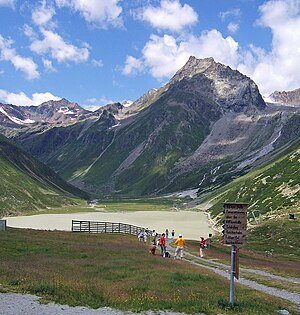Seekogel (Kaunergrat)
| Seekogel | ||
|---|---|---|
|
Seekogel from the east, in front the Rifflsee |
||
| height | 3357 m above sea level A. | |
| location | Tyrol , Austria | |
| Mountains | Ötztal Alps | |
| Dominance | 1.18 km → Rostizkogel | |
| Notch height | 140 m ↓ Scharte between Watzebachferner and Nördl. Away from holes | |
| Coordinates | 46 ° 58 '17 " N , 10 ° 48' 39" E | |
|
|
||
| rock | Veteran | |
| First ascent | July 20, 1899 by F. Hörtnagel and Hans Margreiter | |
| Normal way | South wall and east ridge ( III ) | |
The Seekogel ( 3357 m above sea level ) is considered to be the most rugged summit of the Kaunergrat , a mountain range in the Ötztal Alps in Tyrol . The summit is a torn edge with steep walls to the north and south in the long ridge that branches off to the east from the main ridge of the Kaunergrat between Watzespitze and Rostizkogel . To the north of the summit is the Seekarlesferner , to the east is the Rifflsee . From the east and west the summit appears as a jagged point, from the north and south as a broad wall. Even the slightest ascent up the mountain is serious climbing, there are numerous difficult routes, in particular the west ridge is considered to be an extraordinarily beautiful climb for a primeval rock summit.
Routes
The usual ascent, also the path of the first climber, leads over the south upstream Schneidige Wandl ( 2893 m ), the south wall and the east ridge ( UIAA III ). It is a serious climb in mostly firm, but not cleared and sometimes grassy rock. You are responsible for securing yourself, and abseiling points must be secured with additional material. It takes 5 to 6 hours from Rifflsee to the summit.
In addition to numerous other climbing routes to this summit, the West Ridge ( UIAA IV ) is particularly important, which is considered one of the most beautiful primary rock ridges in Tyrol. This ridge was first climbed by Ingenuin Hechenblaikner and F. Harpf in 1903 in the descent. Access to the west ridge usually takes place from the Riffelsee past the east ridge break on the Seekarlesferner to the north , from which the notch in the west ridge (P. 3224) can be reached. The most interesting is the climbing directly on the ridge, but a lightning strike in 1975 tore apart one of the sharp towers of the west ridge, so that it can only be bypassed by a somewhat tricky crossing on the south flank.
Impressions
Seekogel from Zuragkogel with Seekarlesferner
Literature and map
- Walter Klier : Alpine Club Guide Ötztal Alps . Bergverlag Rudolf Rother , Munich 2006, ISBN 3-7633-1123-8
- Richard Goedeke : 3000 meters in the northern Alps . Bruckmann, Munich 2004, ISBN 3-7654-3930-4
- Alpine Club Card, sheet 30/5, 1: 25,000, Ötztal Alps, Geigenkamm . ISBN 3-928777-44-0
Individual evidence
- ↑ Heinrich Hess , Ludwig Purtscheller : The high tourist in the Eastern Alps. Vol. I, Leipzig 1903, p. 233
- ^ Richard Goedeke: 3000 m in the northern Alps . Page 119, see literature
- ^ Walter Klier: Alpine Club Guide Ötztal Alps . Marginal number 1704, see literature



